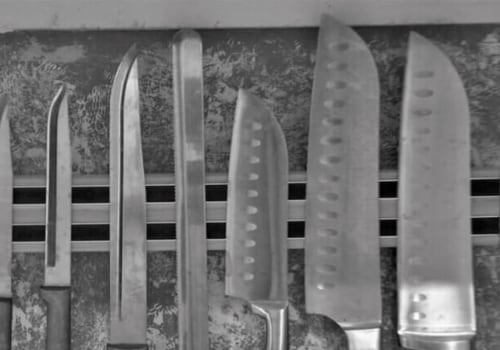In the culinary world, paring knives are essential tools for precision work in the kitchen. These small, sharp blades are the go-to choice for peeling, slicing, and trimming fruits and vegetables. Paring knives may be small, but their versatility makes them invaluable to any cook. Our guide to paring knives aims to help you understand the different types of paring knives available, the best materials for knives, and the best way to take care of your paring knives so they last longer.
Whether you're looking for a knife set to get started or a single knife to add to your collection, our guide to paring knives will help you make an informed decision. Paring knives are a versatile and essential tool in any home cook's kitchen. But with so many types of paring knives available, it can be hard to know which one is right for you. To make the decision easier, it is important to know the purpose of each type of paring knife, as well as the advantages and disadvantages of each. The traditional chef's knife is the most common and recognizable type of paring knife.
It typically has a straight blade that is between 3 and 4 inches long, making it ideal for peeling, slicing, and mincing vegetables and fruits. It is also a great choice for chopping herbs, as the blade has enough surface area to easily press down on them. The serrated knife is another popular option for paring knives. It has a curved blade that is usually between 4 and 6 inches long, which makes it ideal for slicing tomatoes, citrus fruits, and other soft fruits and vegetables.
The serrated edge helps prevent slipping or crushing delicate foods. The bird's beak knife is named for its curved shape, which resembles the beak of a bird. This type of paring knife has a narrow blade that curves outward at the tip. It is perfect for peeling and trimming fruits and vegetables with curved surfaces, such as apples and potatoes.
There are also specialty paring knives available for specific tasks. A santoku knife is a Japanese-style knife with a flat blade that is usually between 6 and 8 inches long. It is ideal for slicing and dicing vegetables and fruits into small pieces. A tournée knife, or vegetable knife, has a narrow blade that curves outward at the tip for better maneuverability when cutting vegetables into thin slices or strips.
A tomato knife has a serrated blade that is designed specifically for slicing tomatoes without crushing them. When choosing a paring knife, it is important to consider your needs and what type of tasks you will be using it for. For example, if you are looking for a knife to peel and trim fruits and vegetables, you may want to opt for a bird's beak or tournée knife. If you need something more versatile that can do more than just peeling and trimming, then a chef's knife or santoku may be better suited to your needs. Once you have chosen the right paring knife for your needs, it is important to learn how to use it properly.
Always use a cutting board when using your paring knife and hold the food firmly in one hand while using the other hand to hold the knife. Make sure you are cutting away from your body in order to avoid any accidents or injuries. Also be aware of the sharp edges on the blade so that you do not cut yourself. It is also important to properly care for your paring knives in order to keep them sharp and in good condition. Sharpening your knives regularly will help keep them from becoming dull over time.
To sharpen a paring knife, use either a honing steel or sharpening stone to carefully run the blade against the steel or stone at a 20-degree angle until it is sharpened. Be sure to use caution when sharpening any type of blade. When not in use, store your paring knives in a safe place away from children or pets. You can also use a magnetic strip or wall-mounted rack to keep them organized and within easy reach when needed. Finally, cleaning your paring knives after each use is important in order to keep them in good condition. Rinse them off immediately after use and then use warm water and dish soap to clean off any residue on the blade.
Dry them thoroughly with a clean cloth before storing them away. Now that you know all about paring knives, here are some tips and tricks for using them effectively in the kitchen: When peeling fruits or vegetables, start by making an incision at one end of the food item and then peel along the contour of its shape until all of the skin is removed; when cutting herbs, hold them together in one hand while using the other hand to chop; when trimming fat off of meat, make sure to hold the fat firmly in one hand while using the other hand to carefully slice it off; when slicing tomatoes, use a serrated knife to minimize crushing; when cutting produce into small pieces, try using a santoku knife for its extra surface area; finally, when dicing vegetables or fruits into cubes, first slice them into thin slices and then stack those slices together before cutting them into cubes. These tips will help you get the most out of your paring knives and make cooking easier and more enjoyable! Whether you are just starting out in the kitchen or looking for ways to improve your cooking skills, having the right paring knives can make all the difference.
Caring for Your Paring Knives
Owning a paring knife is essential for any home cook, but it's just as important to know how to care for your knife properly. Storing, sharpening, and cleaning your paring knife are all essential steps to ensure that your knife performs at its best for years to come.Storing Your Paring Knife
When it comes to storing your paring knife, it’s important to keep it away from other knives. Invest in a knife block or magnetic wall strip to ensure that your paring knife isn’t accidentally damaged by other knives.Additionally, you should never leave your paring knife in a sink full of water as it can cause the blade to rust.
Sharpening Your Paring Knife
Sharpening your paring knife is an important part of its upkeep. Invest in a whetstone or sharpening steel and make sure to use them regularly. You should aim to sharpen the blade every couple of months or after heavy use.When sharpening, be sure to use long, smooth strokes and always sharpen in the same direction.
Cleaning Your Paring Knife
Cleaning your paring knife is also important for keeping it in good condition. After each use, be sure to rinse off the blade with warm water and a mild dish soap. Then, dry it off with a soft cloth and store it away in its designated spot.To avoid damage, never put your paring knife in the dishwasher.
Different Types of Paring Knives
Paring knives are versatile and essential tools in any home cook's kitchen, but with so many types of paring knives available, it can be hard to know which one is right for you. There are several different types of paring knives that all have their own unique characteristics and uses. Here is a breakdown of the different types of paring knives, and examples of how they can be used in the kitchen.Spear Point Paring Knife:
The spear point paring knife is the classic, most common style of paring knife.It has a sharp, pointed tip and a straight blade that curves up towards the end. It is great for tasks such as peeling and coring fruit, cutting small pieces of food, and making decorative garnishes. This knife is also the right size for opening packages or envelopes.
Bird's Beak Paring Knife:
The bird's beak paring knife, also known as a tourné knife, is designed for peeling and shaping vegetables. It has a curved blade that comes to a point at the end, resembling the beak of a bird.This knife is perfect for making decorative garnishes or peeling vegetables with curved surfaces.
Sheep's Foot Paring Knife:
The sheep's foot paring knife has a blunt tip and a straight blade that curves down towards the end. This design makes it safer to use than other types of paring knives, as it is less likely to accidentally puncture food or your fingers. This knife is ideal for slicing cheese, spreading butter, cutting sandwiches, and slicing fruits and vegetables with softer skins.Serrated Paring Knife:
The serrated paring knife has a curved blade with small teeth along the edge. The serrated edge helps it grip onto food while slicing, making it perfect for cutting tomatoes, peaches, and other soft fruits.It can also be used to cut sandwich bread or angel food cake without crushing it.
Tips for Using Paring Knives Effectively
Paring Knives are an incredibly versatile tool in any home cook's kitchen. To get the most out of your paring knife, it’s important to understand how to use them effectively. Here are a few tips and tricks for using paring knives in creative ways in the kitchen. One of the best ways to get the most out of your paring knife is to use it for more than just paring fruits and vegetables. Try using a paring knife to cut through tough meats like chicken or pork.This is a great way to save time and effort when preparing dinner. Paring knives can also be used to quickly mince herbs and garlic. Simply place the herbs or garlic on a cutting board, then carefully press down with the blade of the paring knife, keeping it as steady as possible while you chop away. You can also use paring knives to easily and quickly carve decorative designs into fruits and vegetables. This is a great way to add an elegant touch to your dinner table. When using a paring knife, it’s important to keep the blade sharp. A dull blade is more likely to slip, which can lead to serious injury.
If you find that your paring knife is starting to become dull, simply sharpen it with a sharpening stone or honing steel. Finally, it’s important to always use caution when handling a paring knife. Always keep your fingers away from the blade, and never use the knife without adult supervision. With the right care and attention, your paring knife will last you for years.
How to Choose the Right Knife
Paring knives come in a variety of shapes and sizes, from small bird's beak paring knives to wide blade chef's paring knives. When selecting a knife, consider the size, shape, handle, and the quality of the steel.Size: Paring knives typically range from two to four inches in length. A two-inch knife is great for detailed tasks such as peeling and trimming small fruits and vegetables. A four-inch knife is better for larger fruits and vegetables. Shape: Paring knives come in several shapes, including straight-edged, serrated, and curved.
Straight-edged paring knives are ideal for tasks like peeling and trimming fruits and vegetables. Serrated paring knives are best suited for slicing tough-skinned fruits like tomatoes. Curved paring knives are useful for cutting curved or rounded shapes. Handle: Paring knives come with either a plastic or wooden handle.
Plastic handles are lightweight and easy to clean, but they don't offer as much grip as wooden handles. Wooden handles provide more grip, but can be harder to clean and require more maintenance. Quality of Steel: The quality of the steel used to make the knife is an important factor to consider when selecting a paring knife. Higher quality steel will be more durable and have a sharper edge that will stay sharper for longer periods of time.
Look for paring knives made from high-carbon stainless steel, which is more resistant to corrosion and rust. When selecting a paring knife, consider the size, shape, handle, and the quality of the steel. Consider what tasks you will be performing with the knife and choose one that is best suited for those tasks. With so many options available, you're sure to find one that fits your needs. Paring knives are a must-have for any home cook. With their versatile design and wide range of applications, they are an invaluable tool in the kitchen.
By understanding the different types of paring knives, how to choose the right one, and how to care for them, you can ensure your knives will last for years to come. With this guide, you'll have the knowledge and skills to use your paring knives effectively and get the most out of them.






Leave Reply